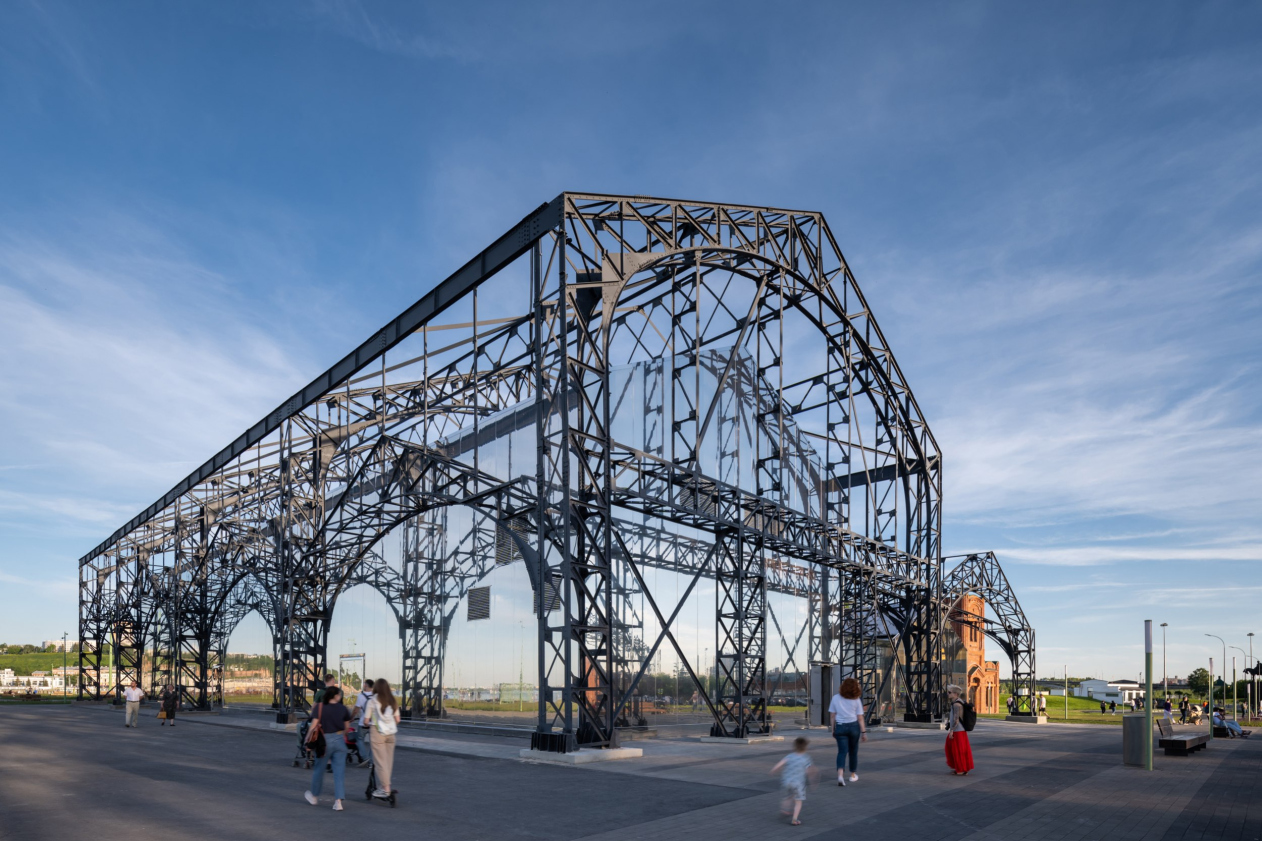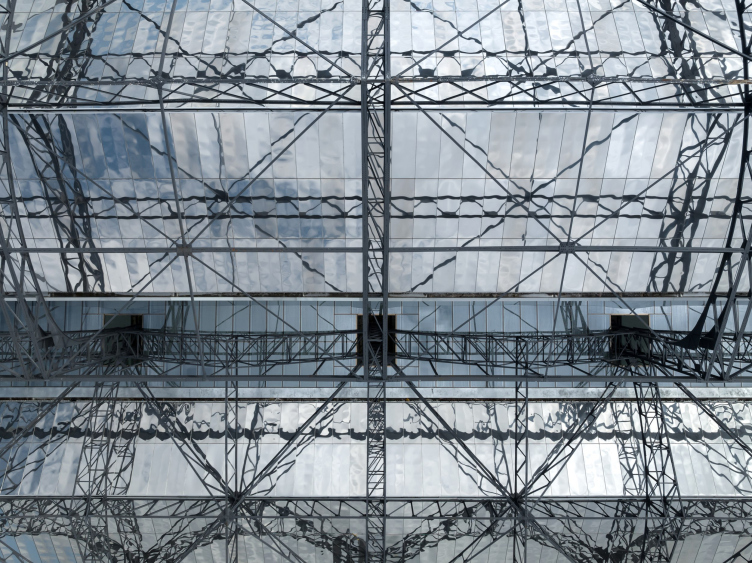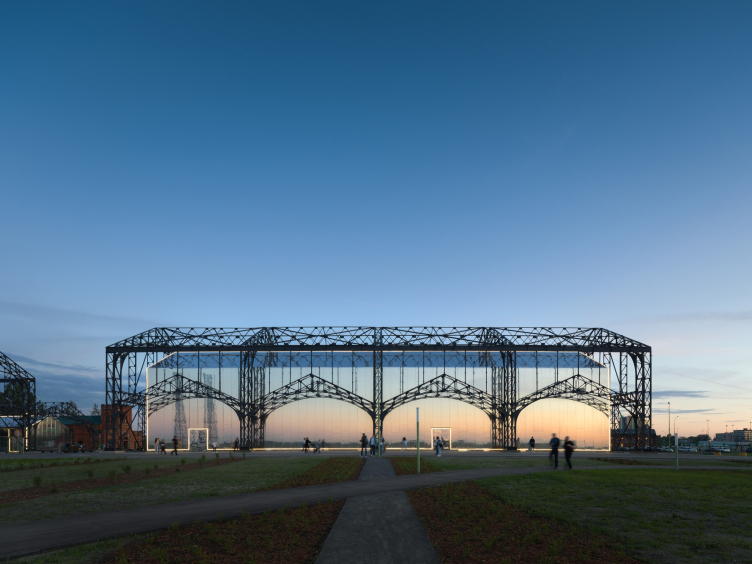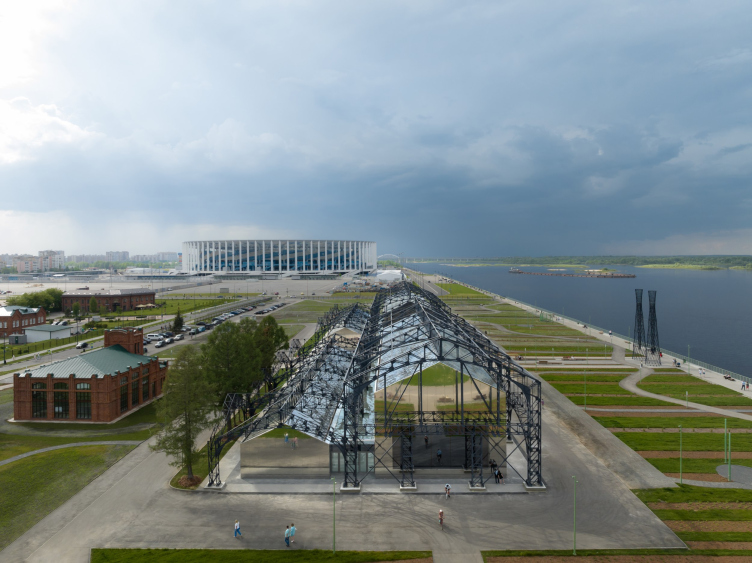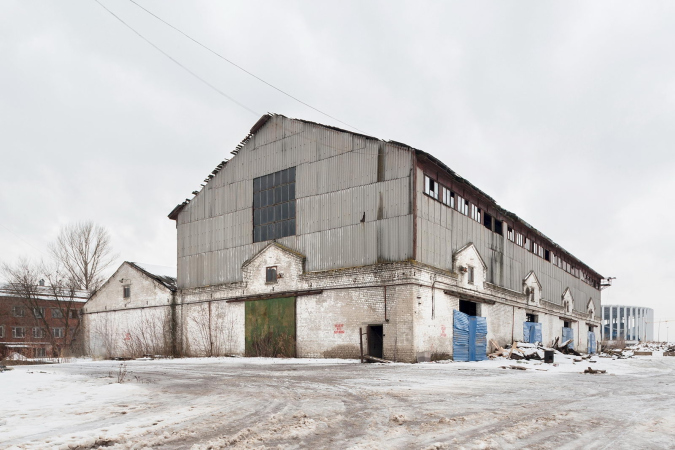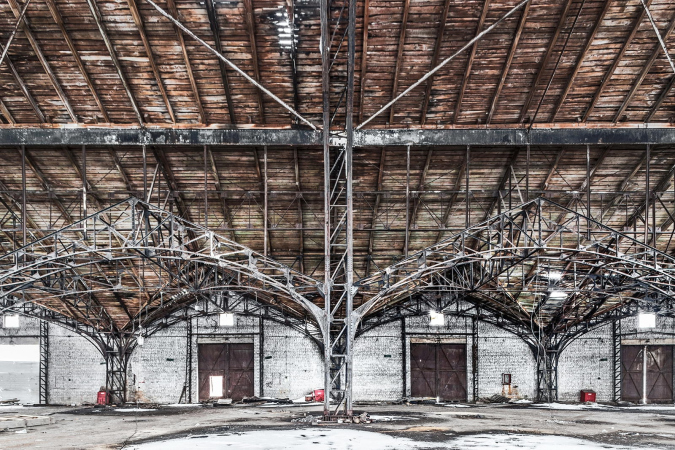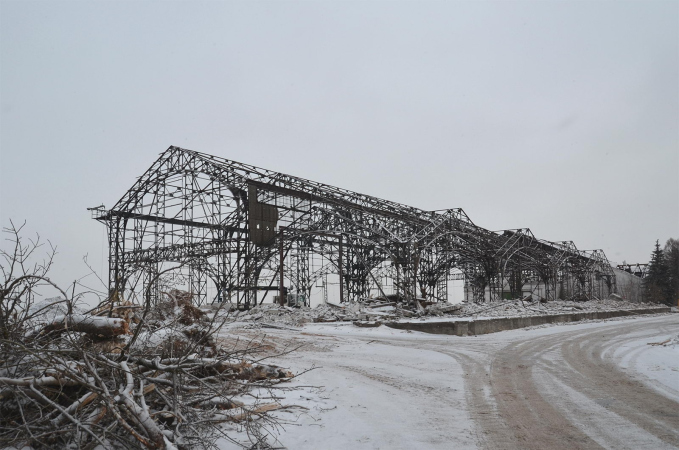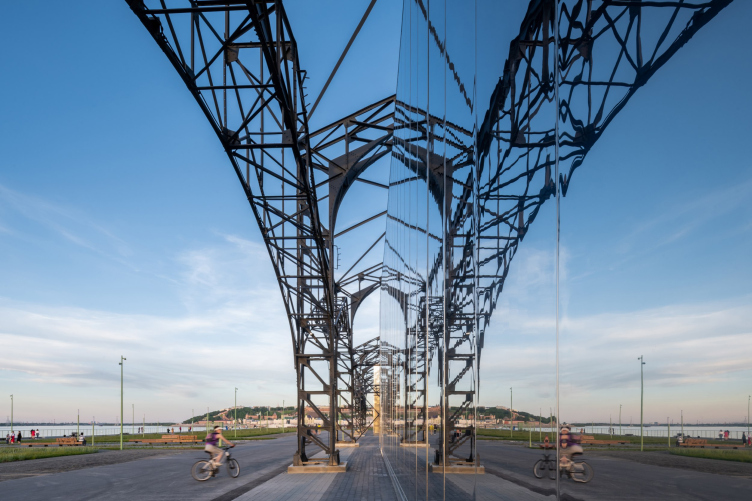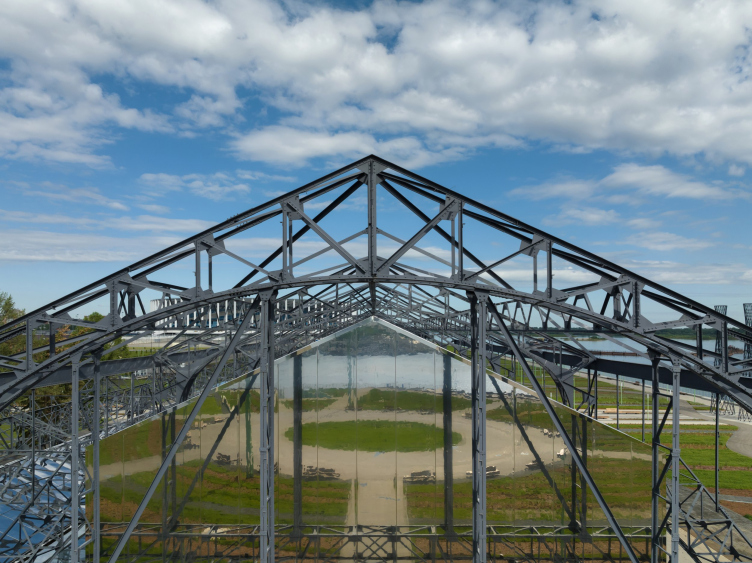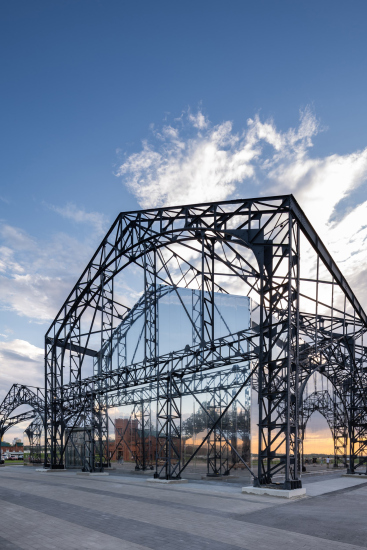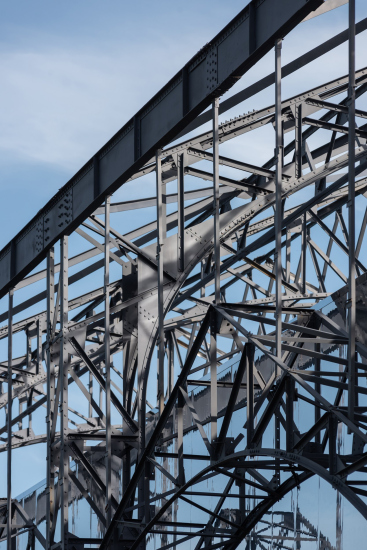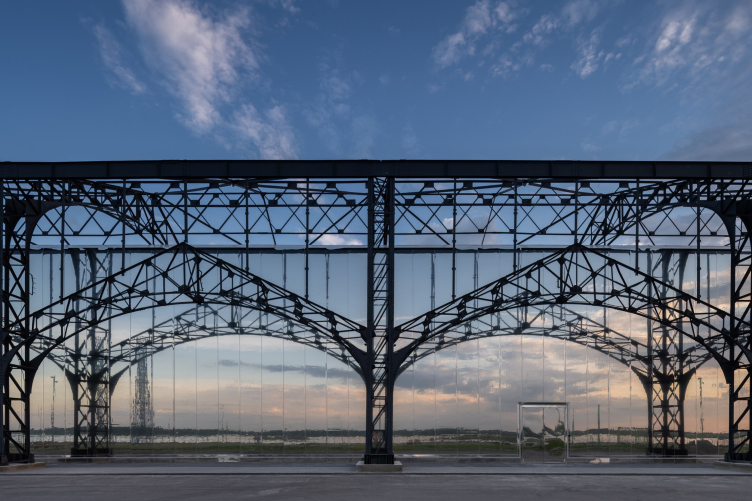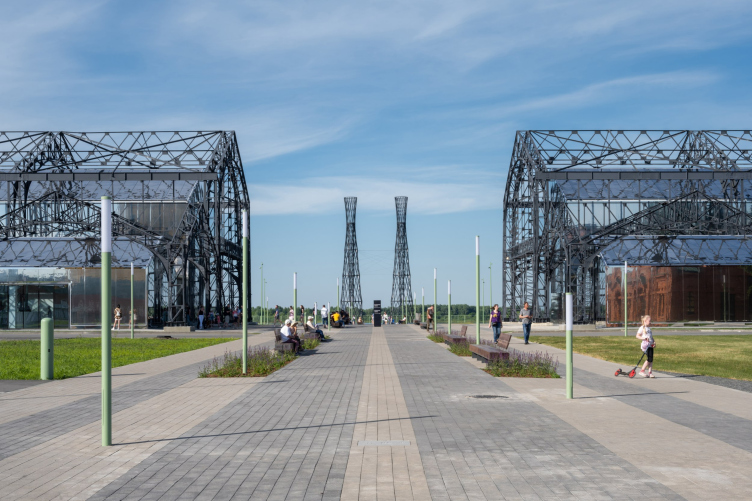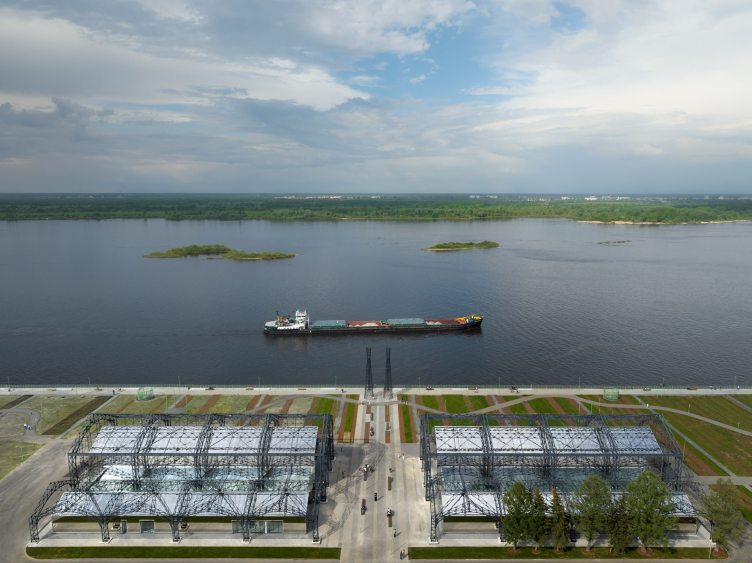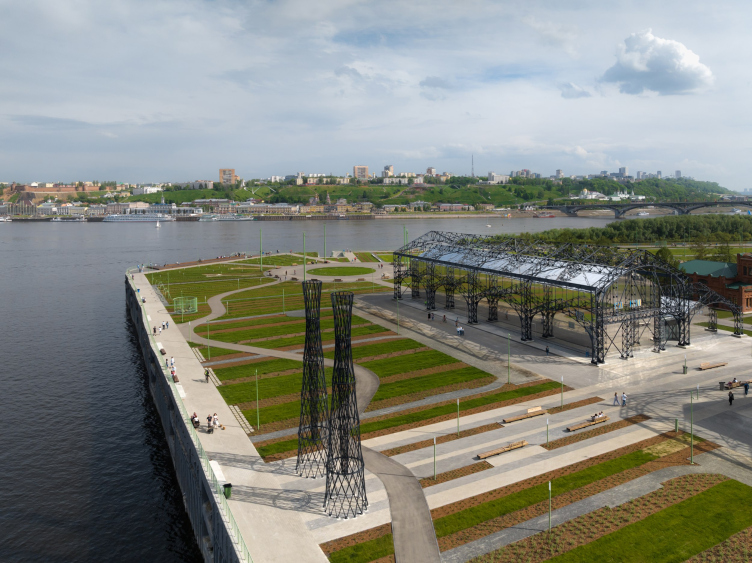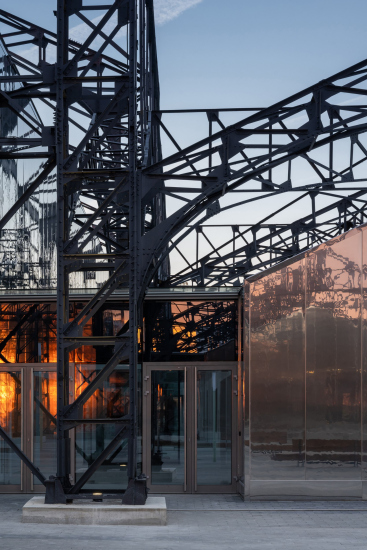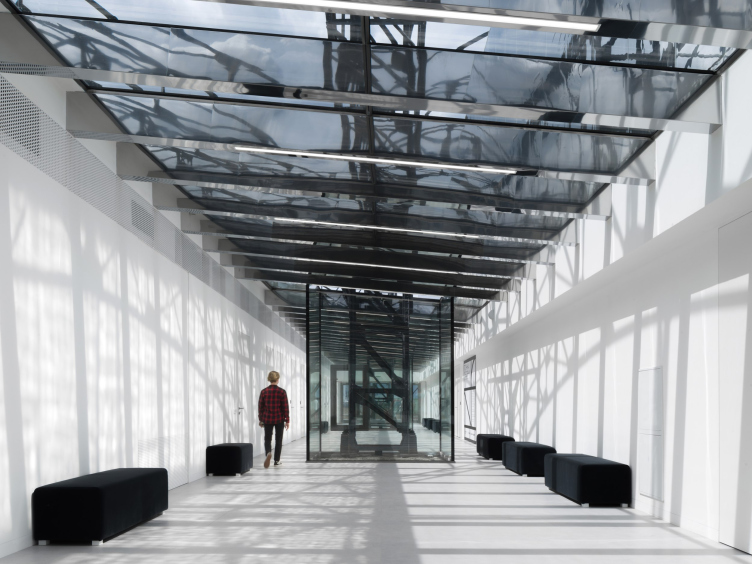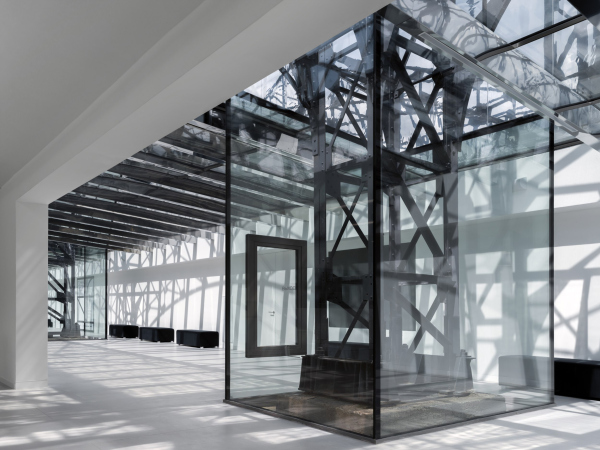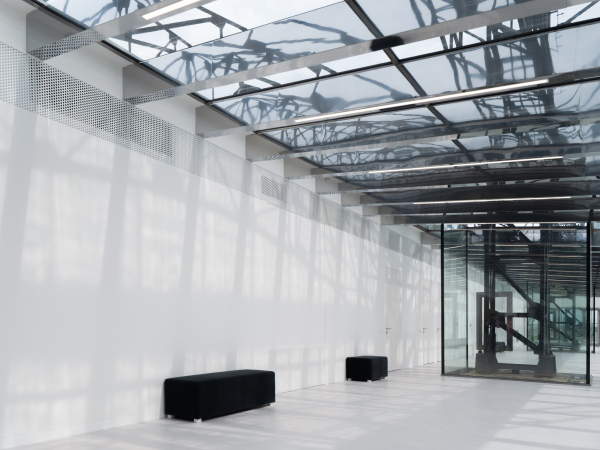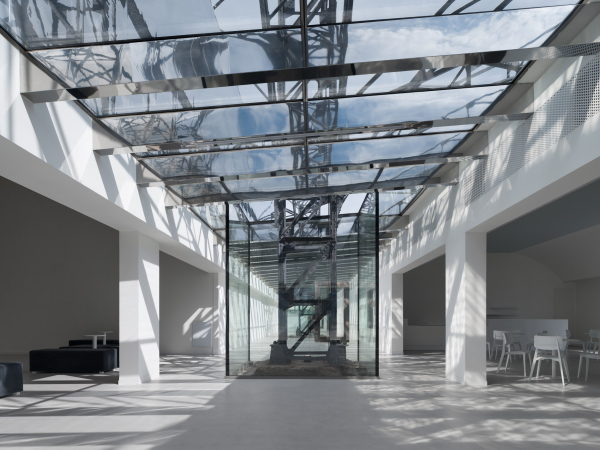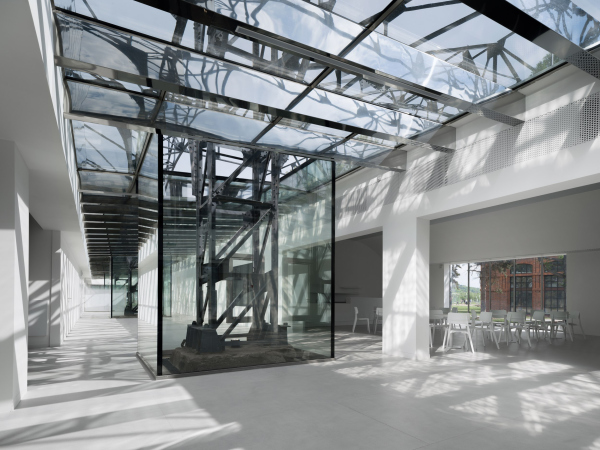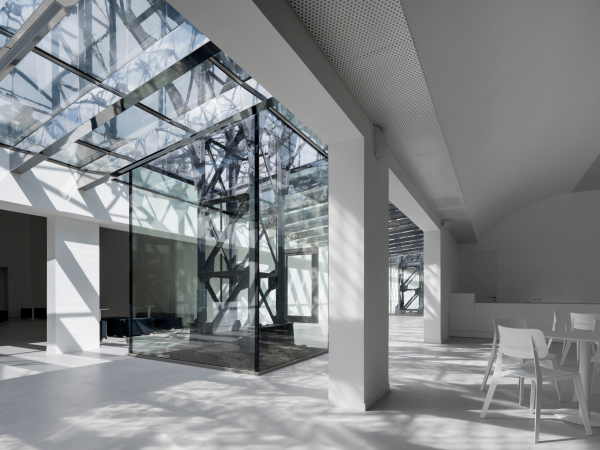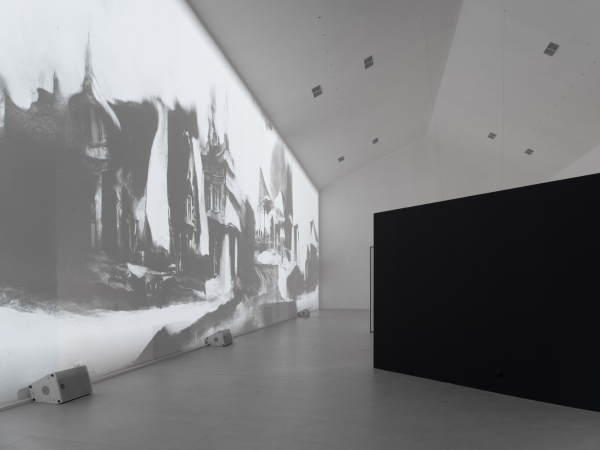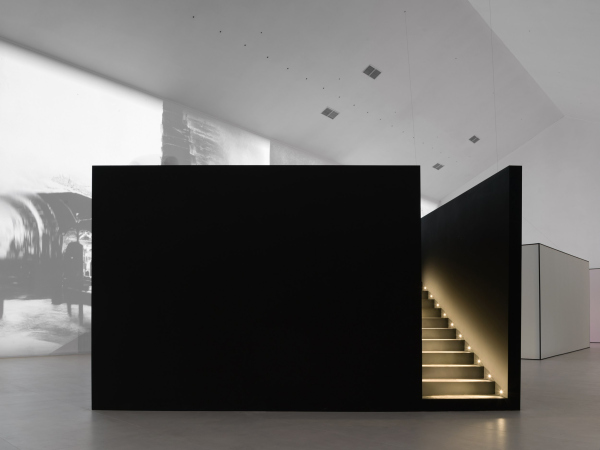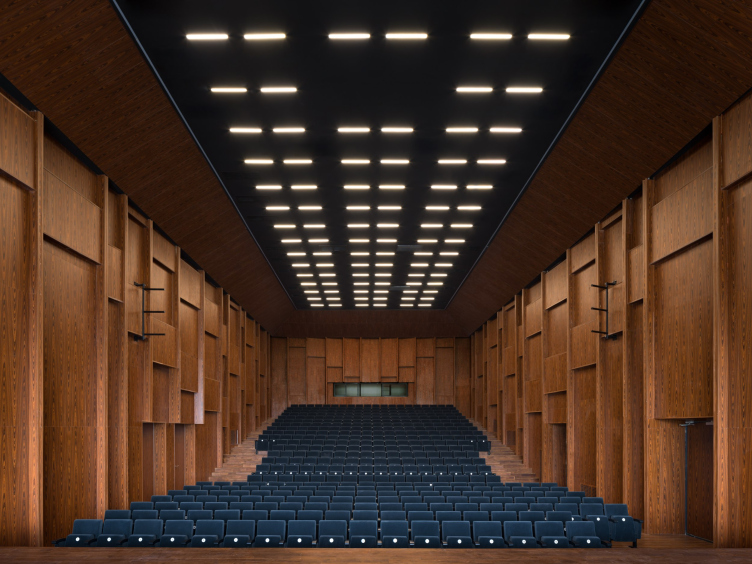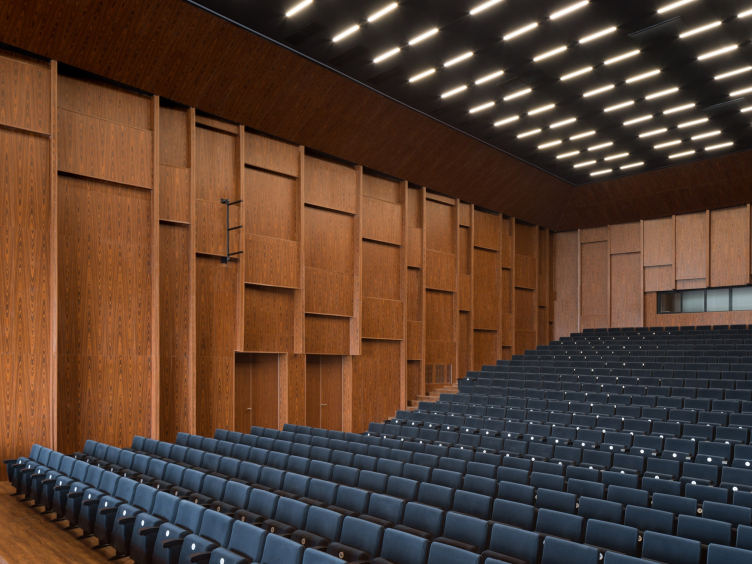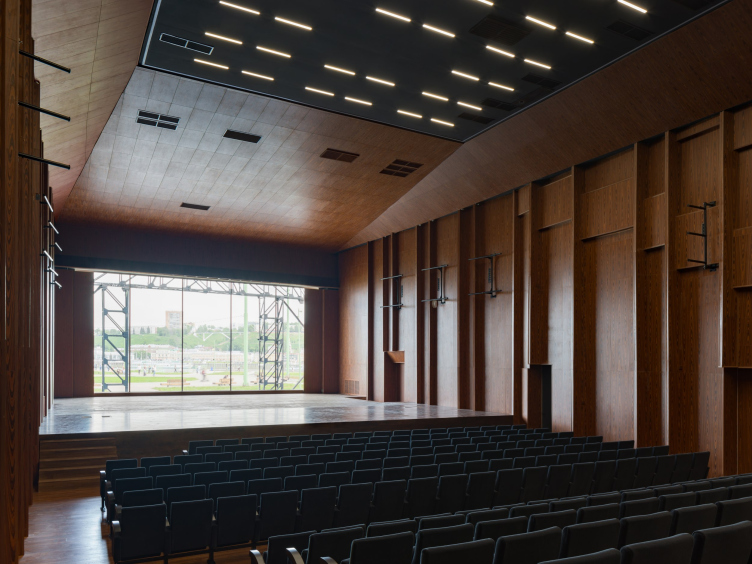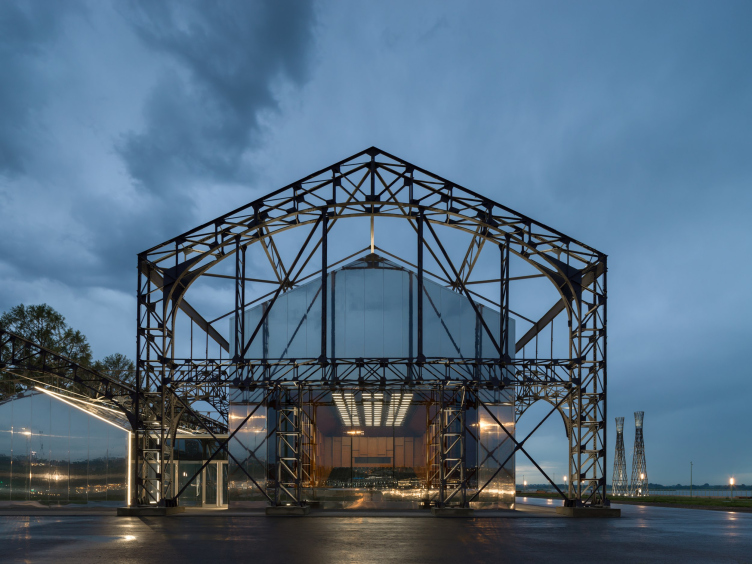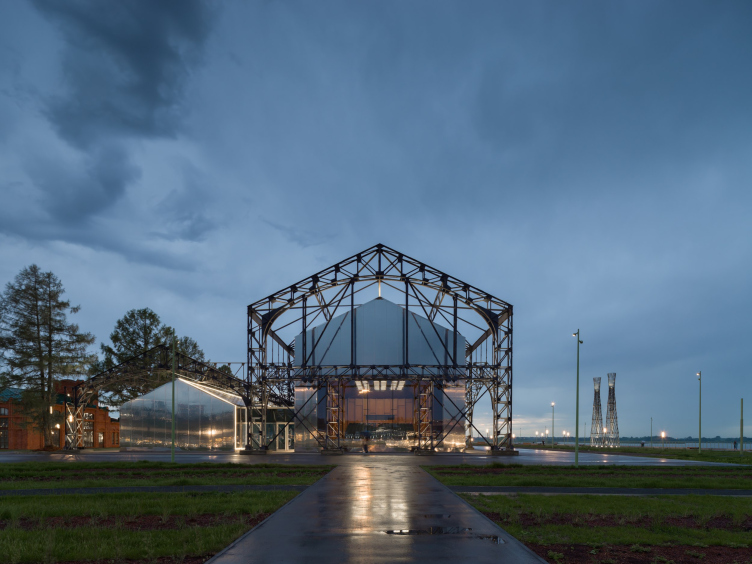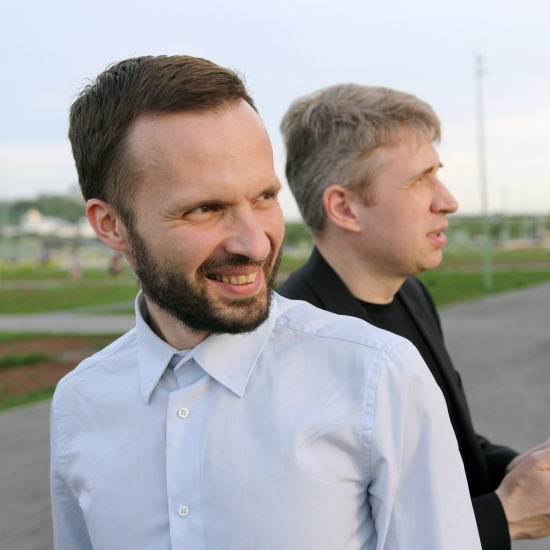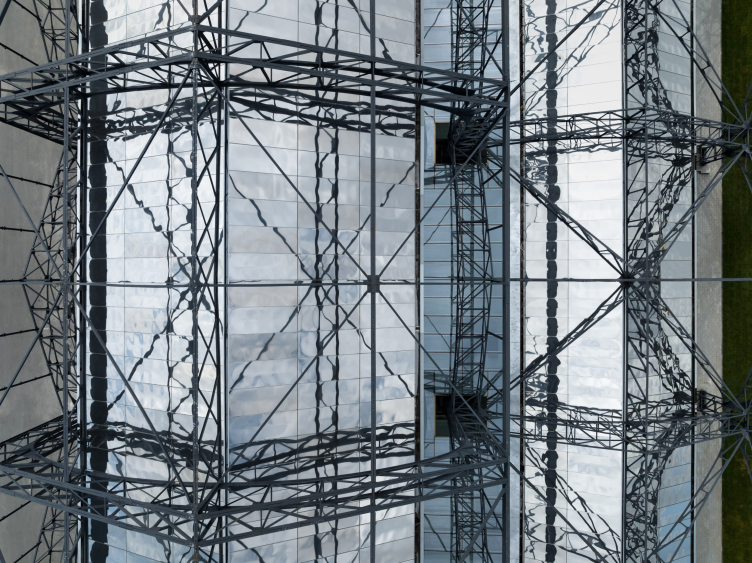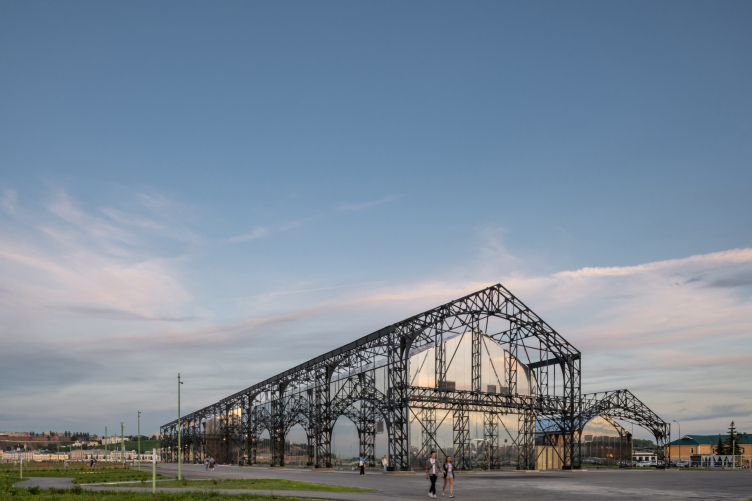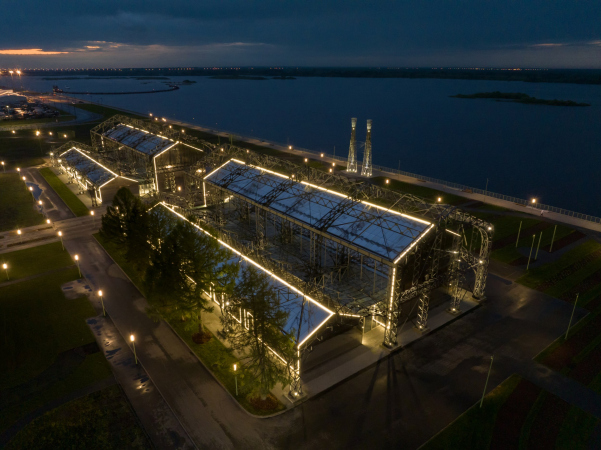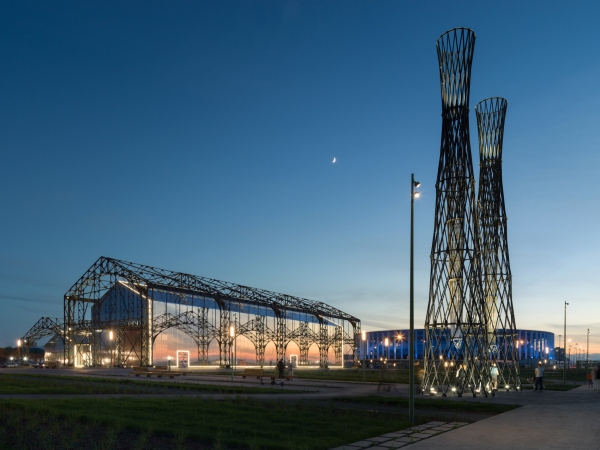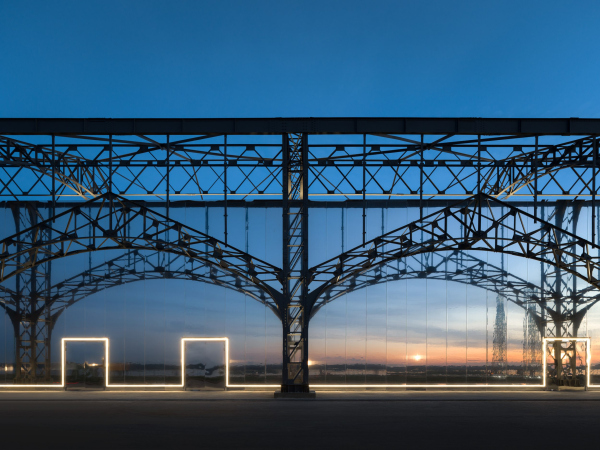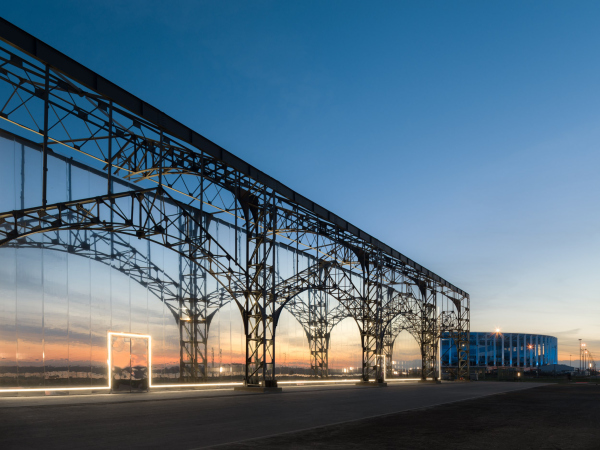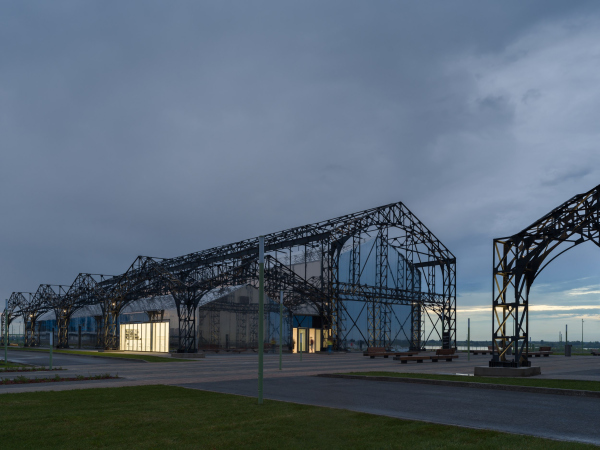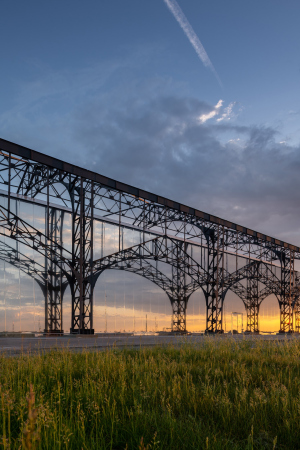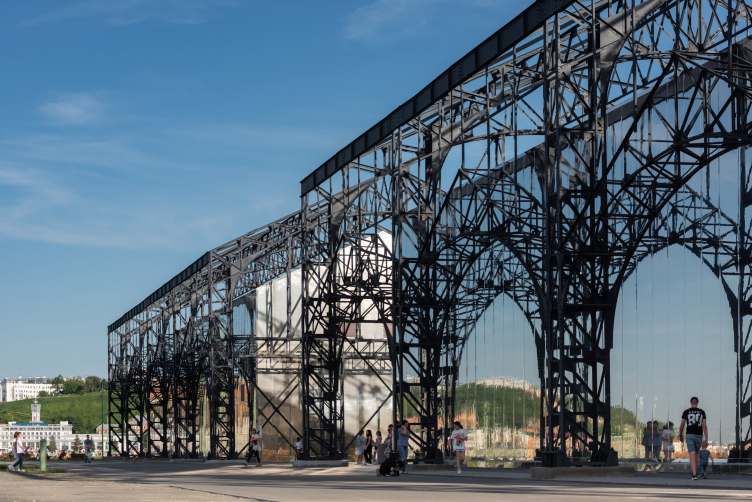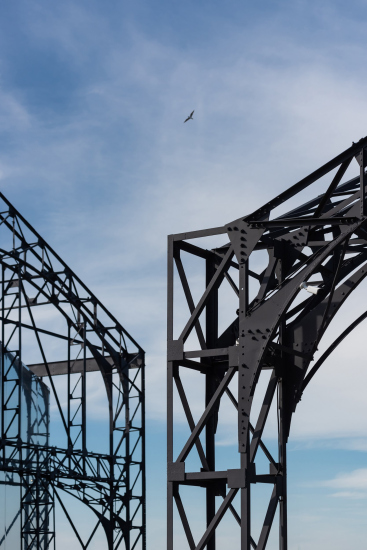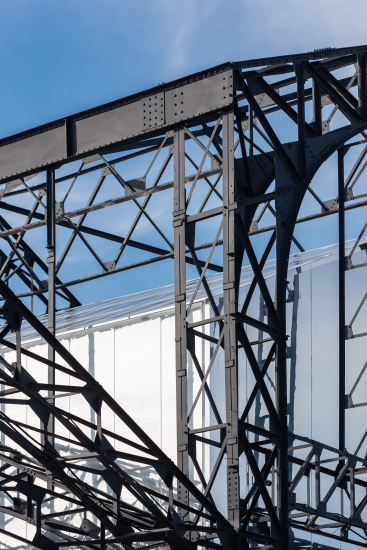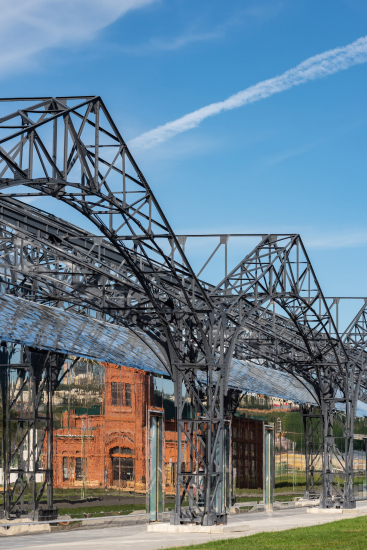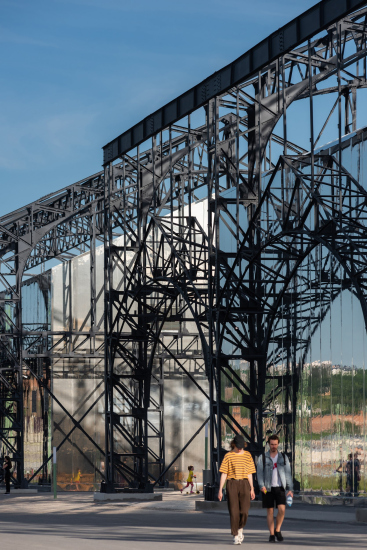[see the story of the warehouses
in the archi-blog by Anna Martovitskaya]
in the archi-blog by Anna Martovitskaya]
The story of saving the “warehouses”, which are in fact the pavilions of the all-Russia trade fair of 1882, discovered in 2015 on the Spit of Nizhny Novgorod, is a model one in terms of intensity and effectiveness of public movement – and innovative in terms of bravery and subtlety of the architectural solution proposed by Sergey Tchoban for transforming them into exhibition and concert halls.
The warehouses of Nizhny Novgorod
Copyright: Photograph © Ilia Ivanov / provided by SPEECH
The architect himself admits some “riskiness” of his project “in respect to the old and the new”: instead of covering the metallic frameworks with some sort of casing from the outside (the obvious choice), the architect left them exposed, inserting inside simple volumes with pitched roofs and facades of mirror-like polished steel.
The warehouses of Nizhny Novgorod
Copyright: Photograph © Dmitry Chebanenko / provided by SPEECH
The warehouses of Nizhny Novgorod
Copyright: Photograph © Ilia Ivanov / provided by SPEECH
The warehouses of Nizhny Novgorod
Copyright: Photograph © Dmitry Chebanenko / provided by SPEECH
The warehouses of Nizhny Novgorod. View from southeast. In the distance, we can see the arena built for FIFA World Cup 2018. On the right, there are two towers designed by Peter Vinogradov, the modern metallic sculptures inspired by Vladimir Shukhov power
Copyright: Photograph © Dmitry Chebanenko / provided by SPEECH
We will emphasize at once that the SPEECH architects were invited to work on the territory of the Spit in 2019, already after the walls and roofs of the warehouses were dismantled in the end of 2017 in the heat of making the final preparations for the World Soccer Championship 2018. The bearing structures survived, but the walls did not – but then again, the walls were essentially a later addition; they were built in the 1960’s and belonged to the fourth stage of the eventful life of this 19th century building (see more info here). When they were a part of the port infrastructure, the outward appearance of the warehouses was unassuming to say the least – one of the first impressions of the tourists, who saw the 19th century structures on the Spit, was how much beauty was concealed inside of seemingly trivial industrial buildings of the Soviet time. Conversely, a lot of admiration for the beauty of openwork structures was expressed after the dismantling of the walls, when the structures became completely open and transparent.
At that time, in 2016-2019, a whole number of adaptation and conservation projects were proposed, some purely conceptual, and some quite realistic. Interestingly, among them there were proposals to leave the metallic structures totally exposed, inserting, for example, amusement rides inside them, and proposals, in which the “metallic lace” was placed inside a heated contour of outside walls and roofs.
Both extreme options, as it turned out, were impractical: first, in accordance with the overall concept of developing the Spit, it was required to use the warehouses for hosting a function more significant than, for example, a summer slide. Second, the predictable version with the outer contour – which originally was considered to be all but the only feasible option – turned out to be questionable upon closer inspection.
In the very first version of 2019, we covered the structures with single-layer glass, placing volumes sheathed in wood inside. However, this solution proved unsuccessful for a number of reasons. First, by doing this, we hid the structures – even if the outer shell is glass, glass is not always truly transparent, more often it hides what is inside. Second, in this case there was a risk of creating an unpleasant greenhouse effect: “dew point” in winter and a very hot environment in summer. In addition, the buildings would have looked unpleasantly massive when viewed from the outside, but inside there would be no useful area for functional filling.
And finally, the structures in their current state were not capable of carrying a new shell. Surprisingly, when we started working with the project, we were told that they could not remain open; when we made the first proposal for the brief that we received, it turned out that the structures could not be closed either, since they could not support anything. Why can’t they? At least because the construction regulations have changed, now there are other load tolerances, so now the structures do not have the right to take on even the weight that they carried before. Consequently, they would need to be strengthened, distorted, and weighted. Any reinforcement of such a structure is a change in its character.
I thought about the problem for a long time and somewhere in the spring of 2020 I came to a conclusion that leaving the structures of the 19th century exposed was the only acceptable solution, the most democratic and elegant. This idea allowed us to preserve the exterior structure in the simplest way, without weighing it down visually. The structures have actually become self-supporting; they hold themselves and can stand for a very long time. In fact, they are now a monument to themselves. This is how we accepted them, preserved them in this capacity and are exhibiting them now.
And finally, the structures in their current state were not capable of carrying a new shell. Surprisingly, when we started working with the project, we were told that they could not remain open; when we made the first proposal for the brief that we received, it turned out that the structures could not be closed either, since they could not support anything. Why can’t they? At least because the construction regulations have changed, now there are other load tolerances, so now the structures do not have the right to take on even the weight that they carried before. Consequently, they would need to be strengthened, distorted, and weighted. Any reinforcement of such a structure is a change in its character.
I thought about the problem for a long time and somewhere in the spring of 2020 I came to a conclusion that leaving the structures of the 19th century exposed was the only acceptable solution, the most democratic and elegant. This idea allowed us to preserve the exterior structure in the simplest way, without weighing it down visually. The structures have actually become self-supporting; they hold themselves and can stand for a very long time. In fact, they are now a monument to themselves. This is how we accepted them, preserved them in this capacity and are exhibiting them now.
The warehouses of Nizhny Novgorod
Copyright: Photograph © Ilia Ivanov / provided by SPEECH
The warehouses of Nizhny Novgorod
Copyright: Photograph © Dmitry Chebanenko / provided by SPEECH
So! This project is all about the key idea. The solution is bold, elegant, and paradoxical. The insides of the historical building turned out to be on the outside, but the mirror facades reflect their structures, duplicating them on the inside, enhancing the impression and producing a lace-like effect, which everyone admired so much after the walls were dismantled in 2017. Well, the effect is not exactly of this kind, but similar: the impression of a metallic skeleton, and “super-graphics” in space, ruin-like and stable, gigantic and brittle, has been saved and retold in a new language, akin to modern art and stage design – both lend themselves to multiple layers and shifting impressions.
The impressions are indeed shifting constantly: the mirrors enhance the dependence on the weather and atmospheric conditions. At certain angles, the illusion of the absence of physical volumes is all but complete. It really looks as if they are just nonexistent; this way, the monument stands out in all its glory.
The warehouses of Nizhny Novgorod
Copyright: Photograph © Ilia Ivanov / provided by SPEECH
Sometimes, the mirror takes on a shade that is lighter than the background, and forms an advantageous backdrop for the super-graphics of the structures, casting light on the dark moldings. This is also one of the perfect impressions, carefully staged.
The warehouses of Nizhny Novgorod
Copyright: Photograph © Dmitry Chebanenko / provided by SPEECH
On an overcast day, the mirrors can also shine against the background of the dark clouds – or can get filled with leaden darkness, and then it becomes particularly noticeable that there is something there on the inside, and this is, by the way, one of the arguments of the project’s critics. We will note here, however, that if you look on the same overcast day, you will see that the buildings, designed in a different paradigm – with facades placed on the outer contour – would look even more voluminous, yet would be devoid of the paradoxical attractiveness of being “turned inside out”, which one way or another is yielded by the open framework.
The warehouses of Nizhny Novgorod
Copyright: Photograph © Ilia Ivanov / provided by SPEECH
This is yet another peculiar feature of this solution – currently, the structures are widely exposed and shown to the entire city – we kept on wandering around Nizhny Novgorod, counting spots, from where they could be seen: from the Kremlin, from the Fedorovskogo Embankment, from the Volga… If they were hidden inside an outer casing, examining the framework would only be possible for those who come inside – but now they have become a fact of the city space, a mega art object. The structures are complemented by two metallic towers – projects by Peter Vinogradov, something akin to the “monument” to the power transmission poles designed by Vladimir Shukhov. Together, the two warehouses and the towers form a symmetrical ensemble, united by the theme of metallic openwork, and meditation on the subject of modern and historical metal: the dark metal of the 19th century warehouses gets reflected in the modern light metal.
The warehouses of Nizhny Novgorod
Copyright: Photograph © Ilia Ivanov / provided by SPEECH
The warehouses of Nizhny Novgorod
Copyright: Photograph © Dmitry Chebanenko / provided by SPEECH
The warehouses of Nizhny Novgorod
Copyright: Photograph © Dmitry Chebanenko / provided by SPEECH
And finally, according to brief, the architects had to endow the warehouses with two cultural functions, turning them into concept and exhibition halls with a foyer. I don’t think I will be mistaken if I say that one could hardly “pack” them into the allotted space as tactfully and efficiently because a mirror is one of the most effective ways to dissolve one reality in another, to hide it without really hiding it, and to divert the observer’s gaze. The halls are there… and they are not there. This effect is to a certain degree the opposite of the presentation of space in classic art where we enter a grand portico and find ourselves in some precious cave. This boundary of the metallic skeleton and mirrors is not material but as ethereal as it gets – the simplest analogy of the entrance to wonderland.
On the inside, we find three kinds of space.
The first kind is the foyers, which are identical in both pavilions. At the entrance, there is a cloakroom and a cafe with a stained glass window, which cuts through the mirrors of the facades; further on, there is a corridor that separates technical rooms and the main function: an exhibition hall in the north building, and a concert hall in the south one. The floor plan follows the logic of the historical metal framework – the 1882 expo pavilions had three aisles each, but, during the time of their service as port warehouses, one minor wing of each of the buildings was lost, so eventually two contours remained. Accordingly, the larger one now hosts the function, and the minor hosts the mechanical rooms. The two aisles of the structures rest upon one row of longitudinal supports; meanwhile you can see two distinct “mirror houses” inscribed into the structure, these two being connected by a corridor with a glass roof. We enter the corridor and walk in a straight line towards the main halls, leaving the foyers behind, left and right.
The interiors are totally white – very much in the spirit of “Teenagers in Space” (a cult Russian science movie for children – translator’s note); the ceilings are equipped with opaque linear lights of the same color.
The corridor – or should we call it a gallery – is particularly interesting. It is built along a row of metallic supports, common for the major and minor volumes. Each support is hidden in a glass casing with an open top, through which rainwater enters, and then is evacuated through a tap at the bottom. The glass barriers have little windows for repair and cleaning – they also help to air the premises. The ceilings of the corridors are not white but glass, with beams of polished metal: the two mirror buildings stretch mirror “threads” towards one another. On the inside, there is plenty of sunlight streaming in through two metallic meshes: of the 19th and 21st centuries.
The warehouses of Nizhny Novgorod
Copyright: Photograph © Dmitry Chebanenko / provided by SPEECH
The corridor with columns is a great addition for the facades with their reflections. Finding ourselves in the “wonderland”, we see not just the out-worldly pristine whiteness, but also receive quite real impressions: exhibiting the 1882 structures continues, albeit in a more intimate environment. Moving from the entrance towards the halls, we cannot help but walk at a close distance from the columns, and if on the outside we may have not paid attention to the flickering lines in the reflections, now the structures are presented to us as a museum exhibit – in a showcase – which, on the one hand, invites us to examine them, and, on the other hand, makes us think about them as a living thing trapped in a man made casing. The impression is reminiscent of trees, around which oftentimes the works of architecture of the 20th century were designed. What we have here, is, of course, not a tree but metal, but metal so old and with such a long history that it can already be likened to a knotted black trunk of some rare plant – all the more so because it “grows” in the wild from the ground.
The two main halls, situated in the neighboring buildings, are comparable in size, but the impressions that they create are completely different. The exhibition hall is white; its pitched ceiling follows the outline of the roof, which, in turn, follows the contour of the historical bearing structures. The hall is as simple as a white box, and it is shut off from the sunlight – all of this falls in with the modern rules of creating the perfect exhibition space: spacious, integral, and completely neutral. To commemorate the opening of the renovated warehouses, an exhibition was organized there in the beginning of June, dedicated to the history of “dismantling and assembling” the structures of the 19th century, as well as to how they were discovered and studied; the exposition was open until the beginning of July (curator Xenia Anufrieva, co-curator Marina Ignatushko). The hall accommodated for a few smaller inner pavilions, one of them being equipped with a viewing platform, and a multimedia projection on one of the walls.
However, the main and the most complex of the inner spaces is the concert hall in the south pavilion. Today, this is the main function of the warehouse ensemble. At the inauguration, many speakers reminisced on the concert that took place here before the reconstruction, outdoors in the driving rain. As for the opening of the hall, which took place on June 1, it was honored by the appearance of the MusicAeterna orchestra conducted by the famous Greek-Russian conductor Teodor Currentzis, known for his reconstructions of historical music, and for the curious fact that he conducts without the conductor’s baton. Currentzis has worked in Novosibirsk, Germany and Perm, and the director of his orchestra, Alexey Trifonov, has been directing the Nizhny Novgorod State Academic Opera and Ballet Theater named after Alexander Pushkin since this year. The hall was created under the supervision of Trifonov and with the participation of Anatoly Livshits, an acoustic solutions specialist, founder and CEO of Acoustic Group.
The warehouses of Nizhny Novgorod
Copyright: Photograph © Dmitry Chebanenko / provided by SPEECH
According to Livshits, modern concert halls can be subdivided into traditional “boxes” and innovative “vineyards”, the difference being that in the former the space is rectangular, and the stage is situated up front, while in the latter the spectator seats are placed around the stage – and for the better sound quality the classic solution is preferable. The concert hall in the warehouses is a typical “box”, and not an excessively large one, either, meaning that in Anatoly Livshits opinion this was the correct traditional solution. The hall is decorated with acoustic panels of rosewood laminate of a dark-crimson hue, their stepping relief being simple enough; the hall is cozy because, by contrast with the white foyer, it is almost fully dominated by the wood grain. Sergey Tchoban calls it “a treasure chest for listening to music”, and this metaphor seems very appropriate both because of the warm colors of the hall and its comparatively small size – it is designed for 430 spectators.
The warehouses of Nizhny Novgorod
Copyright: Photograph © Dmitry Chebanenko / provided by SPEECH
Not being an expert, I cannot make judgements about the acoustic properties of the hall – the music did sound wonderful but I will leave the subtleties to professionals. However, the window behind the stage, practically its whole width, commanding a sweeping view of the Volga, the Oka estuary, and the high bank of the Kremlin wall, all put in the framework of exquisite pillars of the 19th century, was very impressive – it was obvious that it was one of the main attractors of the hall. The orchestra played with the open window, although the construction of the stage provides for the possibility of closing it with a special curtain, for those occasions – as was specified at the inauguration – when “the content of the concert or performance does not presuppose admiring the views”.
The warehouses of Nizhny Novgorod
Copyright: Photograph © Dmitry Chebanenko / provided by SPEECH
The window makes the pavilion open to the world: despite the fact that we are inside an indoor facility with carefully calculated acoustic characteristics, and are securely protected from the wind and the rain, we still have an opportunity to admire the cityscape – one of the benefits of the Spit is preserved here as well. On the other hand, some kind of logical connection appears between the open structures on the outside and the open stage on the inside: they let us into the space “on the other side of the mirror” – just to lead us through it and bring us back again to the city, and this presents a whole new experience.
The concert hall is clearly visible from the outside through the stained glass window, especially in the evening. The warehouses of Nizhny Novgorod. The south facade
Copyright: Photograph © Dmitry Chebanenko / provided by SPEECH
The warehouses of Nizhny Novgorod
Copyright: Photograph © Dmitry Chebanenko / provided by SPEECH
At this point, we must remember that before the start of the warehouse project, at the end of 2019, Sergey Tchoban also worked with the spatial vision – something like a preliminary master plan – of developing the Spit as a whole. It was planned that hotels and offices would be built all along the Oka River, and expo grounds would be in the center. It was also expected that a philharmonic hall would be built on the cape, and an exhibition center north of the warehouses. It must be said that things tend to change very quickly in Nizhny Novgorod, and, for all intents and purposes, this master plan is probably no longer relevant. It is easy to see, however, that the already-built pavilions of the warehouses “imbued” the two functions of their nonexistent neighbors: the concert and the exhibition ones.
The implementation of the project, which was fast enough, particularly in view of the fact that the work began in 2020, and continued during the lockdown period, was far from easy, but the architects are satisfied with the overall result.
This project was very interesting and far from simple. There were quite a lot of changes and heated debates. In the process of designing, the area of the concert hall changed, and the layout changed slightly as well. We tried to implement everything, as far as possible, the way it was drawn from the very beginning. There were a lot of last-minute adjustments.
Nevertheless, the project has been implemented, and the idea is fully reflected in this implementation. The volumes are laconic, elegant, almost invisible both due to the fact that they repeat the basic geometry, and due to the minimalism of their solution, and, of course, due to the mirroring of the facade material. Reflections emphasize and complement the outline of the structure, open, not hidden under either facade or roof – the volume itself now exists inside the structure, in fact, we breathed life into this structure. Previously, it was covered by a shell, but now it has become a facade.
Nevertheless, the project has been implemented, and the idea is fully reflected in this implementation. The volumes are laconic, elegant, almost invisible both due to the fact that they repeat the basic geometry, and due to the minimalism of their solution, and, of course, due to the mirroring of the facade material. Reflections emphasize and complement the outline of the structure, open, not hidden under either facade or roof – the volume itself now exists inside the structure, in fact, we breathed life into this structure. Previously, it was covered by a shell, but now it has become a facade.
The mirror volumes are clad in facade sandwich cassettes with a coating of polished stainless steel: a little bit more than a meter wide, 4 cm thick, and up to 13 meters high in the central parts of the side-end facades. The roofs are also covered with polished stainless steel, but their cassettes are slightly shorter, and more attention is paid to waterproofing. The vertical facades step back from the structures by 1.8 meters, leaving room for cleaning and repairs, and at the same time forming the right distance for reflection – so that the lace of the “real” metal and its reflection would not get in each other’s way. In the roofs, the distance between the historical carcasses and the new surfaces ranges from 50 cm for the major volumes to 20 cm for the minor ones.
The warehouses of Nizhny Novgorod
Copyright: Photograph © Dmitry Chebanenko / provided by SPEECH
The warehouses of Nizhny Novgorod
Copyright: Photograph © Ilia Ivanov / provided by SPEECH
The volumes have white LED backlighting bands installed in them, which run around the doors and the stained glass windows of the cafes and the concert hall, as well as follows the contours of all the ribs, enhancing the laconic shape of the inner volumes in the nighttime: the light lines, growing inside the dark and rather tangled web of the structures and their reflections, yield in the dark a rather interesting effect of “stitching” the old with the new.
A few words should also be said about the historical structures as such. They were preserved in the location, to which they were moved in the 1960’s during the reconstruction of the port, which included rotating them at a 90-degree angle, and they rest on concrete bases manufactured at the same time; today, the bases are covered with new neat casings of exposed concrete. The 19th century metal was covered by a thin layer of anti-rust formula developed by Nizhny Novgorod specialists. Due to the fact that all the structures are exposed, and, as was mentioned earlier, are exhibited in the open air, they are easy to examine, all the more so because in addition to the natural light the mirrors provide extra light from the rear side. When we were there, they created all the conditions for us to admire the 1882 structures. When you examine them, you see that the structures are mainly composed of metallic bands and triangles; you will not see here any of the less refined T-bars, characteristic for later periods, which was emphasized still in 2015 by historian Tatiana Vinogradova. Sometimes, bolts are visible among the round riveting heads – probably traces of the post-war reassembly.
The warehouses of Nizhny Novgorod
Copyright: Photograph © Ilia Ivanov / provided by SPEECH
There are two things that I want to say here. The metallic framework does impress with its sheer scale – it is rather large – and the openwork interlacing in space. Upon closer inspection, however, you notice that the structures are not as slender and lace-like as they seemed at first sight. The 19th century produced much more interesting cast iron structures for interior decoration – first of all, more detailed, sporting arches, loops, capitals, and bases. It’s enough to cast a quick glance at Joseph Paxton’s Crystal Palace to understand that the Nizhny Novgorod – well, made in Moscow, in fact – the Nizhny Novgorod structures of the all-Russia expo are, of course, good, but rather on the simple side, not to say brutal, particularly if you judge by the 140-year-old standards, and were essentially designed as temporary ones. Hardly anyone could expect in 1882 that they would resurface to be exhibited as a monument of architecture.
This is another paradoxical thing about the pavilions. The very complicated history of their existence, discovery, and reassembly gave them an air of interest which added to their purely aesthetic value. This, of course, was enough of a reason to accompany the opening ceremony with a historical exhibition. On the other hand, over the last century and a half we have come to appreciate brutal works of art, yet at the same time we have seen so many of them that the pragmatic structures of the 19th century appear to us more aesthetically appealing than they might have to their contemporaries. And, finally, the very mode of exhibiting – the open-air type, turned inside out, enhanced by reflections in steel mirrors so much loved by modern art, makes a lot for the presentation of these structures specifically as a monument, a subject of admiration, i.e. performs the function similar to that of a frame in the picture of New Age.
In other words, the idea proposed by Sergey Tchoban, being essentially the exact opposite of the whole practice of preserving such structures, and, hence, being fresh and new [even though some similar examples of modern architecture, generally inclined to admire frameworks, can be found in London’s gas holders, however different], this idea, we repeat, in the story of the Nizhny Novgorod warehouses – the main thing worthy of attention- became the means of representing them as something valuable, despite their temporary and utilitarian origin. This is how an interesting kind of tension appears between the eternal and temporary: something that was subject to deconstruction, removal, and lying in parts, survives a number of transformations, then gets rediscovered, arouses admiration, and ends up being elevated to a pedestal, backlit and reflected in mirrors. This is a very modern approach, which can be traced back to the museum and restoration practice of the 19th century, and based upon the fact that “beauty lies in the eye of the beholder”. This approach invites the observer to think about time as a stream capable of devouring things and, by sheer wim, wash something ashore and bring it to light. And it reminds us that the temporary and eternal can trade places at any moment. So it was not by chance that the orchestra that played at the opening ceremony was called MusicAeterna. What can be more fleeting and at the same time more timeless than music?
This approach is diametrically opposite to the project of building on the Spit a cathedral with a giant belfry, much remembered in Nizhny Novgorod: you may try to stall time all you want, may even try to turn it back – but time has a strategy of its own, and it slips through your fingers again and again, at the same time showing us that eternity lies in a plane slightly different than the one where people tend to look for it.
Information | back to top /|\
The metallic structures, manufactured by the St. Petersburg metallic plant, were a part of the main pavilion built for two all-Russia fairs (XV and XVI) of 1882 and 1896. It is generally considered that the first one summed up the results of the country’s development under Alexander II, and the second one under Alexander III. The circular pavilion with a 300-meter diameter and eight three-aisle volumes, included in the ring, was designed by the architect A.Rezanov and designers G.Pauker and I.Vyshegradsky. The “main pavilion” stood on Moscow’s Khodynka field until 1895, hosting a succession of exhibitions. Then it was taken apart and transported to Nizhny Novgorod for the next all-Russia exhibition, which was then located in Kanavinskaya Sloboda, which today is the 1st of May Park, 3 km southwest of the Spit. At the exhibition, the pavilion performed as a whole, but then it was sold out in parts – and this is how the 4 four three-aisle volumes ended up being warehouses of the Siberian Port of the Nizhny Novgorod fair; then they were logically inherited by the Soviet port on the spit. By 1943, only two were left out of the four pavilions, and in 1960’s they were turned 90 degrees and placed a little more to the East, parallel to the Volga. Right about that time, each of the pavilions “lost” its third aisle: the surviving structures consist of one larger and one smaller volumes; the walls were stopped with bricks. From the outside, they looked very much like ordinary industrial warehouses. The structures were discovered by sheer chance: first it was Xavier Houy and his architectural students who staged their experiments with the wind on the Spit in 2011-2013, then, after the port facilities were removed and the territory began to be prepared for the World Soccer Championship 2018, the warehouses were discovered by the members of the 2015 guided tour. From that moment, the protection and study of the buildings began: Denis Plekhanov, comparing the plans and contours of the buildings, proves that the preserved warehouses are part of the main pavilion of the exhibitions of 1882/1896. Then there were several attempts to demolish and move the structures, especially before the 2018 FIFA World Cup, for which a stadium was built here, on the Spit, but a little more to the west.

